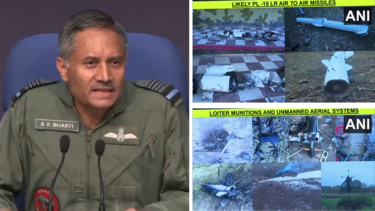SOURCE: AFI


Chinese social media platforms are ablaze with frustration following reports that India recovered multiple PL-15E air-to-air missiles, some nearly intact, after recent aerial engagements during Operation Sindoor on May 7, 2025. The recovery of these advanced Chinese-made missiles, used by the Pakistan Air Force (PAF), has triggered a heated online debate, with Chinese netizens shifting from initial praise of their weapon systems to deflecting blame onto Pakistan’s operational tactics.
In the early stages of the conflict, Chinese social media users lauded the PL-15E, a beyond-visual-range (BVR) missile with a claimed range of 200-300 kilometers, as a game-changer for the PAF. Posts celebrated its advanced active radar homing and dual-pulse motor, positioning it as superior to Western counterparts like the AIM-120 AMRAAM. However, as reports surfaced that Indian forces retrieved several PL-15E missiles—some barely damaged—from crash sites in Pakistan-occupied Kashmir (PoK) and Indian territory, the narrative shifted. Chinese netizens began downplaying the recoveries, accusing the PAF of misusing the missile’s capabilities.
Continue readingSOURCE: AFI


Pakistani defense analysts have expressed growing frustration over the performance of Turkish-supplied Byker YIHA III Kamikaze drones, with several units found crashed well within Pakistan’s own territory. The drones, intended for precision strikes, have come under scrutiny following reports from the Armed Forces Intelligence (AFI) that at least four Byker YIHA III drones malfunctioned and crashed inside Pakistan, as evidenced in recent viral videos. Additionally, drones deployed to target Indian territory in Jammu and Kashmir during Operation Sindoor on May 7, 2025, were intercepted and neutralized by Indian air defenses, failing to achieve their objectives.
The Byker YIHA III, a Turkish-designed loitering munition supplied to Pakistan, was touted for its combat-proven capabilities in conflicts like Syria and Ukraine. However, its recent failures have raised questions about its reliability and Pakistan’s operational proficiency. Videos circulating on social media, particularly from Sialkot, show Pakistani civilians attacking downed Byker YIHA III drones, mistakenly believing them to be Indian, highlighting a lack of awareness and adding irony to the situation.
Continue readingSOURCE: AFI


In a bold move to bolster national security, India has fast-tracked its ambitious Space Based Surveillance (SBS-3) program, slashing the timeline for deploying 52 spy satellites from four years to just one. Approved by the Cabinet Committee on Security in October 2024, this Rs 22,500-crore ($3 billion) initiative aims to enhance India’s ability to monitor its borders, particularly activities in Pakistan, and provide critical support during natural disasters like floods and earthquakes.
The SBS-3 program involves a collaborative effort between the Indian Space Research Organisation (ISRO) and private industry. ISRO will develop 21 of the satellites, while three private companies—Anant Technologies, Centum Electronics, and Alpha Design—have been tasked with producing the remaining 31. These firms have been directed by the Ministry of Defence to compress their development timelines to 12-18 months, with the satellites now targeted for deployment by the end of 2026 or earlier, compared to the original 2028 schedule. This accelerated timeline follows the recent Operation Sindoor, a response to the Pahalgam massacre, highlighting the urgency of enhancing India’s surveillance capabilities amid heightened regional tensions.
Continue readingSOURCE: AFI


Hindustan Aeronautics Limited (HAL), a leading Indian defense company and a significant trading partner of a Russian arms agency, has firmly denied allegations that it resold sensitive British technology to Russia. The statement comes in response to concerns raised about the potential transfer of critical equipment supplied by the U.K.-based H.R. Smith Group, a major aerospace manufacturer and a prominent donor to the populist Reform U.K. party.
According to a New York Times investigation, shipping records from 2023 and 2024 revealed that H.R. Smith Group exported equipment to India, including transmitters, cockpit equipment, and antennas, which had been flagged as critical components for Russian weapon systems. These exports raised concerns about whether the technology could have been diverted to Russia, especially given HAL’s longstanding defense ties with Russian entities. However, HAL has categorically stated that the sensitive British technology remained in India and was not transferred to any third parties.
Continue readingSOURCE: IANS


The budgetary and policy support provided by the government to the forces over the past decade helped build an impregnable air defence shield that helped repulse attacks by Pakistani forces, which was exhibited during India’s anti-terror ‘Operation Sindoor’, said the Director General of Military Operations (DGMO) in a press briefing on Monday.
All airbases and military bases are operational and ready for their next missions, said Air Marshal A.K. Bharti, dismissing misinformation attempts.
Continue readingSOURCE: IANS


India on Monday dismissed Pakistan’s attempts to distort facts around the impact of Operation Sindoor, calling it a predictable disinformation campaign aimed at misleading its own citizens and downplaying the extent of damage inflicted by Indian strikes on terror infrastructure in Pakistan and Pakistan-occupied Kashmir (PoK).
The officials said this during the Director General of Military Operations (DGMO) press briefing in New Delhi on Operation Sindoor, responding to questions about Pakistan’s narrative surrounding the funeral of terrorists killed in the operation.
Continue readingSOURCE: IANS


Following the 2019 Pulwama terror attack and the subsequent Balakot airstrikes, India’s military and strategic establishment reassessed its doctrine of deterrence, with an emphasis on raising the bar both militarily and politically. This reassessment resulted in the “carefully calibrated” strikes under ‘Operation Sindoor’, which marked a departure from previous patterns of limited or reactive engagement, said military sources.
Officials privy to the planning described the approach as deliberate and differentiated, designed to reflect a shift in India’s military paradigm. “You don’t play the same card twice,” said a senior source, referencing the Balakot strike. “There was a need to demonstrate evolving thinking and show that red lines had been crossed — not just in rhetoric, but in the scale and selection of military targets.”
Continue readingSOURCE: PTI


Former Indian Army chief General Manoj Naravane has slammed questions being raised on the suspension of hostilities between India and Pakistan, saying war is not romantic and is not a Bollywood movie.
Speaking at an event in Pune, General Naravane said if ordered, he would go to war, but diplomacy would be his first choice. He said there is trauma among people living in the border areas, including children who have seen shelling and have to run to shelters at night.
Continue readingSOURCE: IANS


Pakistan’s Inter-Services Public Relations Director General (DGISPR) has dismissed rumours about having an Indian female pilot in its custody, stating that it is all part of disinformation campaign and false reporting following the latest intense and aggressive confrontation between the two neighbouring countries.
During a press conference chaired by DGISPR and Senior officials of Pakistan Navy and the Pakistan Air Force (PAF), Lt. General Ahmed Shareef Chaudhry urged the public not to fall for misinformation.
Continue readingSOURCE: PTI


Punjab Police on Sunday said it has arrested two persons including a woman for their alleged involvement in espionage activities linked to a Pakistani official posted at the High Commission in Delhi. Based on credible intelligence, a suspect was arrested for leaking sensitive information to a Pakistan-based handler regarding Indian Army movements, Director General of Police Gaurav Yadav said.
Those arrested have been identified as 31-year-old Guzala and Yameen Mohamad, residents of Malerkotla. Police teams have also recovered two mobile phones from their possession, Yadav said.
Continue readingSOURCE: RAUNAK KUNDE / NEWS BEAT / IDRW.ORG


In a significant revelation, the Director General of Air Operations for the Indian Air Force (IAF) confirmed that the IAF has successfully downed multiple Pakistan Air Force (PAF) aircraft, preventing them from entering Indian airspace. While exact numbers were not disclosed, the DG Air Ops stated, “We have definitely downed a few PAF planes. Don’t want to get into the numbers even though we have a number. But their aircraft were not allowed to enter our airspace.”
According to IAF sources cited by idrw.org, at least three PAF jets were shot down over Pakistani airspace, with two attributed to Indian air defense missile systems. A key piece of evidence supporting these claims is the recovery of debris from a 40N6E missile, part of India’s S-400 air defense system, inside Pakistan. The 40N6E is the longest-range missile in the S-400 arsenal, capable of engaging targets up to 400 km away, underscoring the IAF’s ability to neutralize threats from significant distances.
Continue readingSOURCE: RAUNAK KUNDE / NEWS BEAT / IDRW.ORG


In a strategic move to address its maritime capability gaps, the Indian Navy has initiated government-to-government discussions with the United States and France for the procurement of twin-engine light Naval Utility Helicopters (NUHs). According to sources familiar with the development, the Navy has reached out to the embassies of both nations and engaged with leading manufacturers, including European aerospace giant Airbus, to acquire all-weather, twin-engine NUHs.
The Indian Navy has outlined specific requirements for the helicopters, emphasizing their critical role in enhancing operational flexibility. The NUHs are expected to be in the 5-tonne weight category and equipped with folding blades to enable seamless operations from warships to shore and vice versa. This procurement aligns with the Navy’s long-standing need for 111 such helicopters to strengthen its maritime surveillance, logistics, and search-and-rescue capabilities.
Continue readingSOURCE: RAUNAK KUNDE / NEWS BEAT / IDRW.ORG


In a significant boost to India’s defense manufacturing capabilities, a state-of-the-art production plant for the BrahMos-NG (Next Generation) missile was inaugurated in Lucknow. The facility, designed to produce 150 units of the advanced supersonic cruise missile annually, marks a pivotal step in enhancing the Indian Air Force’s (IAF) precision strike capabilities. The opening comes on the heels of the IAF’s successful deployment of the BrahMos-A missile, which recently delivered devastating precision strikes on Pakistan Air Force (PAF) airbases, showcasing the missile’s formidable power.
The BrahMos-NG, a smaller and lighter variant of its predecessor, weighs just 1.3 tons, making it compatible with all IAF fighter jets, including light combat aircraft. This versatility is expected to significantly expand the IAF’s operational flexibility, enabling a broader range of platforms to carry and deploy the missile. Unlike the heavier BrahMos-A, which is primarily deployed by larger aircraft like the Su-30 MKI, the BrahMos-NG’s compact design ensures it can be integrated across the IAF’s diverse fleet.
Continue readingSOURCE: AFI


The Pakistan Air Force (PAF) has become the subject of widespread mockery in India after claiming to have destroyed an Indian Air Force (IAF) S-400 air defense system at Adampur Air Force Station. The PAF released satellite imagery, circling a random patch of dirt and proclaiming, “S-400 targeted!” However, Indian satellite imagery experts have debunked the claim, confirming that the latest images show no signs of impact or damage in the area.
The PAF’s presentation, which included a satellite image labeled “PAF Response (Targeting S-400 at Adampur),” showed a zoomed-in section of a barren patch with a red circle, alongside text claiming “Orthorectified imagery of S-400 for accurate engagement.” The image, however, lacked any visible signs of destruction, such as craters, debris, or damaged equipment, raising immediate doubts about the claim’s authenticity.
Continue readingSOURCE: AFI


On May 10, 2025, a U.S. Department of Energy (DoE) aircraft, identified by the registration N111SZ and hex code A03192, was tracked rushing to a nuclear storage facility in Pakistan. The aircraft, a Beechcraft B350, was deployed in the wake of a series of precision strikes by India on multiple Pakistani military and nuclear sites, including Nur Khan, Sargodha, Jacobabad, Bholari, and Kirana Hills. These strikes, which occurred on May 9, 2025, were aimed at neutralizing Pakistan’s nuclear capabilities, escalating tensions in an already volatile region.
Flight tracking data from Flightradar24 shows the DoE plane operating in the Lahore Flight Information Region (FIR), with coordinates at latitude 33.53584 and longitude 73.0565, near Islamabad and Rawalpindi. The aircraft was flying at a ground speed of 150 knots (true airspeed 132 knots, indicated airspeed 125 knots) and a Mach speed of 0.196, as reported at 08:39 UTC on May 11, 2025. The plane’s squawk code was 2063, and its ICAO 24-bit address matched the hex code A03192, confirming its identity.
Continue reading